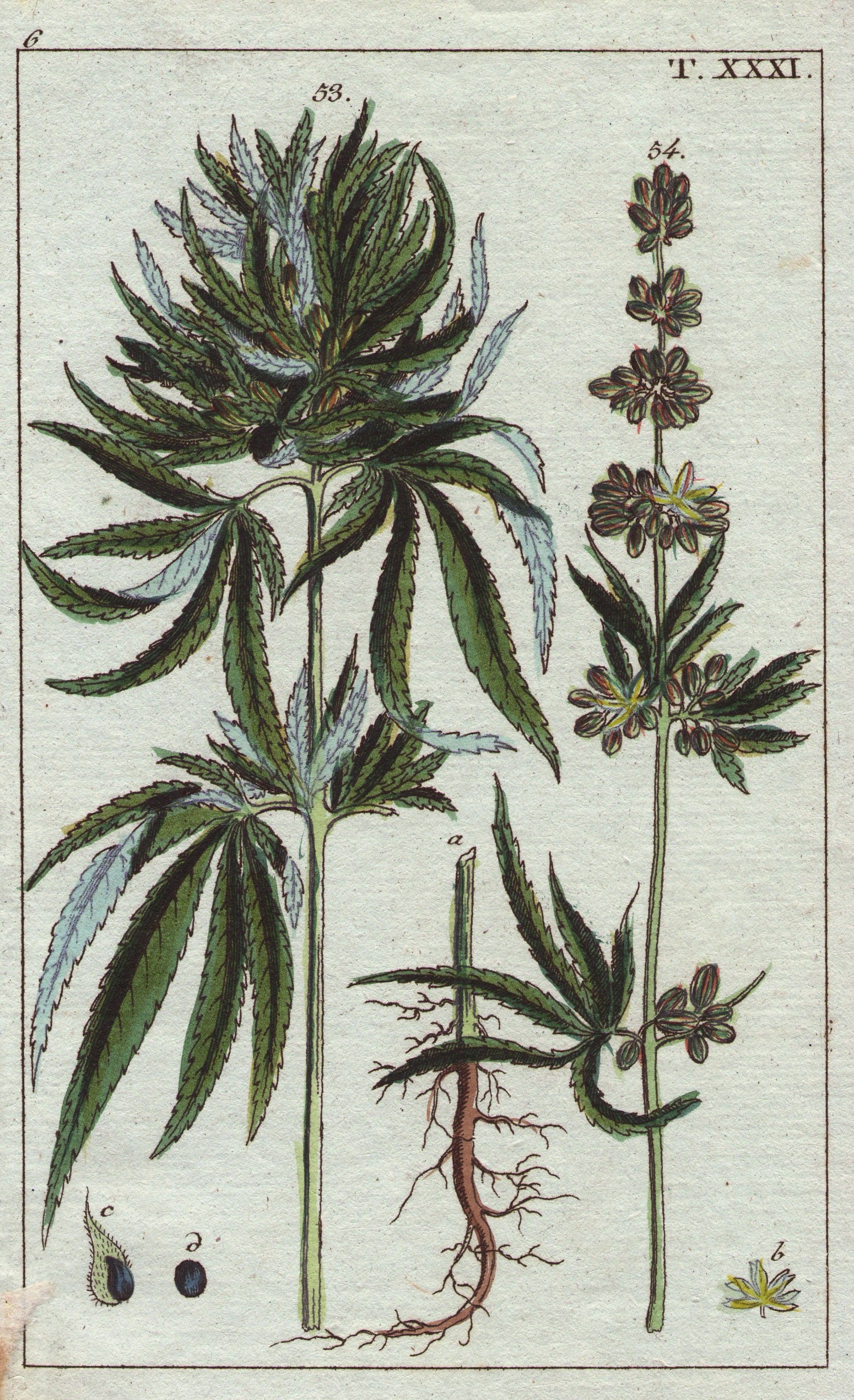 Cannabis plant with leaves, buds and roots.. Handcolored copperplate engraving from G. T. Wilhelm's "Unterhaltungen aus der Naturgeschichte" (Encyclopedia of Natural History) 1820. Gottlieb Tobias Wilhelm (1758-1811) was a Bavarian clergyman and naturalist in Augsburg, where the first edition was published.[/caption]
Cannabis plant with leaves, buds and roots.. Handcolored copperplate engraving from G. T. Wilhelm's "Unterhaltungen aus der Naturgeschichte" (Encyclopedia of Natural History) 1820. Gottlieb Tobias Wilhelm (1758-1811) was a Bavarian clergyman and naturalist in Augsburg, where the first edition was published.[/caption]
The Global History of Medicinal Marijuana
Medicinal marijuana—legal in 34 U.S. states as of September 2020—has played a key role in various cultures over the centuries. The following is a timeline of its history:- 2900 BC – China
- 1450 BC – Israel
- 1213 BC – Ancient Egypt
- 1000 BC – India
 Digitally improved reproduction of hashish smoking, original print from the year 1899[/caption]
Digitally improved reproduction of hashish smoking, original print from the year 1899[/caption]
- 700 BC – Middle East
- 200 BC – Ancient Greece
- 70 AD – Ancient Rome
- 1611-1762 – North America
- 1621 – England
 Cannabis indica fluid extract, American Druggists Syndicate, pre-1937[/caption]
Cannabis indica fluid extract, American Druggists Syndicate, pre-1937[/caption]
- 1745-1824 – United States
- 1799 – France
- 1840s – Western Society
Why Did the U.S. Outlaw Cannabis in the 20th Century?
In the 1910s, prohibitionist mentality took over mainstream culture in the U.S. As a result, American states and cities began to outlaw cannabis. Massachusetts banned cannabis in 1911, followed by Wyoming and Indiana in 1913. New York City followed suit in 1914, and then Utah and Vermont the following year. Colorado and Nevada imposed the same restrictions in 1917. [caption id="" align="aligncenter" width="207"] REEFER MADNESS, aka (TELL YOUR CHILDREN, aka THE BURNING QUESTION), 1936.[/caption]
Why did legislators outlaw cannabis during this time? It wasn’t due to concern about marijuana use, but an effort to discourage future marijuana use in line with certain legislation. This might explain why, despite these restrictions, U.S. pharmaceutical farms continued to grow up to 60,000 pounds of cannabis per year through 1918.
Meanwhile, 10 additional states passed marijuana Prohibition laws from 1915 through 1927. A decade later, the federal government passed the Marihuana Tax Act of 1937—though by this time every state had already criminalized the possession and sale of cannabis.
The new law allowed physicians and pharmacists to prescribe marijuana for an annual fee (and an added tax), but most opted out. Medical testing of marijuana came to an end around this time as well. And ultimately, as states began to re-legalize medicinal marijuana, one thing has become increasingly clear: Cannabis has for millennia played a vital role in medicine—in large part during the pre-Prohibition era.
REEFER MADNESS, aka (TELL YOUR CHILDREN, aka THE BURNING QUESTION), 1936.[/caption]
Why did legislators outlaw cannabis during this time? It wasn’t due to concern about marijuana use, but an effort to discourage future marijuana use in line with certain legislation. This might explain why, despite these restrictions, U.S. pharmaceutical farms continued to grow up to 60,000 pounds of cannabis per year through 1918.
Meanwhile, 10 additional states passed marijuana Prohibition laws from 1915 through 1927. A decade later, the federal government passed the Marihuana Tax Act of 1937—though by this time every state had already criminalized the possession and sale of cannabis.
The new law allowed physicians and pharmacists to prescribe marijuana for an annual fee (and an added tax), but most opted out. Medical testing of marijuana came to an end around this time as well. And ultimately, as states began to re-legalize medicinal marijuana, one thing has become increasingly clear: Cannabis has for millennia played a vital role in medicine—in large part during the pre-Prohibition era.
